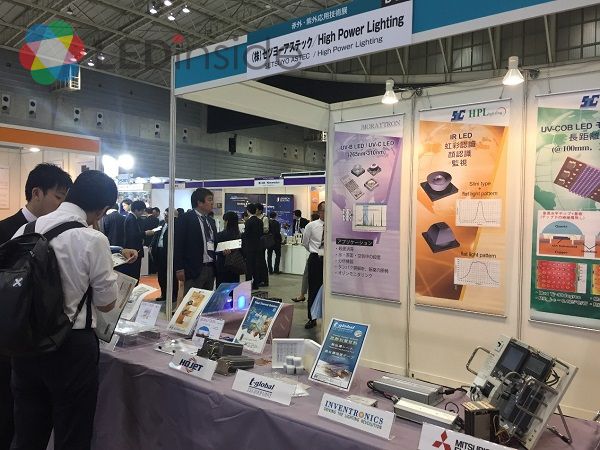(Author: Joanne Wu/ LEDinside)
The 2017 Optics & Photonics International Exhibition (OPIE ’17) took place in Yokohama, Japan from April 19 to 21, which gathered leading technology providers and manufacturers who are seeking solutions. OPIE ’17 and IR+UV Expo were co-located with LASER EXPO, LENS EXPO, Positioning EXPO, Medical & Imaging EXPO, Space & Astronomical Optics EXPO and Industrial Camera EXPO. According to the organizer, exhibitors were mostly laser, lens, IR and UV packaging and application manufacturers. Attendees were buyers and manufactures who aimed to better understand the latest technologies and market trends. The Expo is considered a barometer of the state of the art in the industry.


UV LED manufacturers attending the Expo included Japan’s Nitride Semiconductors and USHIO; Taiwan’s HPLighting and UVT, as well as U.S. maker Phoseon. This year, most UV-A LED manufactures still focused on UV curing solutions. The standard UV curing market is already over-crowded, but high-speed curing is a segment that presents a lot of opportunities. The main reason is this solution requires high irradiance and advanced packaging technologies due to high-speed paper feeding. In addition, the market is gaining momentum because the number of vendors adopting these solutions has increased compared to 2016.
After acquiring Epitex, Japanese vendor USHIO now owns product lineup covering a broad range of wavelengths. UV-A LED in the 365nm and above wavelength range is used mainly for UV curing. In addition, by utilizing USHIO’s own modules and equipment, the company has stable production capacity. With advanced IR LED technologies, USHIO offers products operating at a wavelength of 1650nm. The 1650nm IR LEDs meet market demands and have great growth potential. USHIO also exhibited blue and red laser modules for laser projectors, which continue to be steady profit generators.



Nitride Semiconductors partnered with Seoul Viosys to develop UV LED products, including LEDs, modules, and end products. In 2017, they launched a 275nm UV-C LED lineup. The single-chip option can deliver 13mW at 150mA, while the four-chip module can deliver 30mW at 400mA. As for end products, it introduced several applications for sterilization and deodorization, which can even support wireless charging. In the future, UV LED end products are expected to focus more on consumer needs to increase product popularity.
Toyoda Gosei uses flip-chip technology in developing UV LED products. It showcased UV-A LEDs at 385nm, 395nm and 405nm, which are used mainly in printing systems. The company has adjusted product offering based on market demands, and aims to develop 365nm UV-A LEDs and deep UV LED products in the future.
Taiwan’s High Power Lighting (HPLighting) is a major UV and IR LED vendor. Over the years, HPLighiting has worked closely with chip vendors like EPILEDS and focused on LED packages and optical design. The company has successfully developed UV and IR LEDs based on its competitive advantages. Charles Wei, General Manager of HPLighting, said HPLighting will continue to enhance its packaging technology and optical design for invisible light LEDs to address market and customer needs.
AT OPIE’17, HPLighting demonstrated three product and technology solutions. The first is UV-A COB LED. While other vendors have increased radiation intensity by reducing illumination area using modules, HPLighting can offer radiation intensity for over 8W/cm2 at less than 100mm. As a result, the LED can meet the radiation area requirement of the print format and high speed printing.
The second is 270nm-275nm UV-C LED for sterilization and purification. Sampling of 10mW at 150mA products has been completed with small-volume shipment underway, and new products have been scheduled for release in the third and fourth quarters of 2017.
The third product is IR LED for iris and facial recognition. It uses first optical design to provide a special form factor. Once the light source is concentrated, the plane light will be radiated onto the human face evenly to facilitate facial recognition. Currently, the LEDs can be slimmed down to 2.4mm and 1.6mm, offering great design advantages for camera modules and camera brands. The IR LED has been introduced to notebook PCs.
UVT continues to focus on UV-A LED market, and it reported continues growth in revenues from 2016 to 2017. Its main products include PCB exposure units for high-speed printing, and unique UV curing solutions. In addition, it also produces IR LEDs and IR lasers for security surveillance and automatic license plate recognition purposes. Highlights of its LED package products are 6868 LED and 9090 LED. The latter can deliver 50W at 10A.





 CN
TW
EN
CN
TW
EN


















